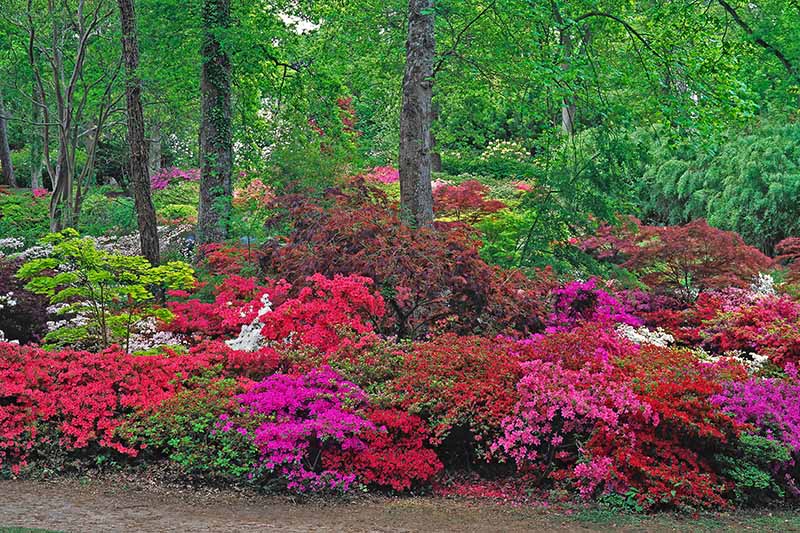Understanding the Difference Between Perennials and Annuals
When it comes to gardening, understanding the difference between perennials and annuals is crucial for creating a thriving and low-maintenance outdoor space. Perennials are plants that live for more than two years, often regrowing new growth from the same roots year after year. These plants typically require less maintenance, as they don’t need to be replanted every year. Examples of perennials include flowers like coneflowers, black-eyed susans, and, of course, azaleas.
On the other hand, annuals are plants that complete their life cycle within a year, germinating, growing, producing seeds, and dying all within a single growing season. Annuals often require more maintenance, as they need to be replanted every year. Examples of annuals include marigolds, petunias, and impatiens.
So, what does this mean for azaleas? Are azaleas perennials or annuals? To answer this question, we need to consider the growth habits and lifespans of azaleas. Azaleas are a type of flowering shrub that can live for many years, producing beautiful blooms in the spring. However, some azalea varieties may be tender perennials or annuals in certain climates, requiring special care to survive the winter months.
Understanding the difference between perennials and annuals is essential for providing the right care for your azaleas. By knowing whether your azaleas are perennials or annuals, you can tailor your gardening strategy to meet their unique needs, ensuring they thrive and produce beautiful blooms for years to come.
What Are Azaleas? A Brief Overview of These Beautiful Flowers
Azaleas are a type of flowering shrub that belongs to the Rhododendron family. They are native to Asia, Europe, and North America, and are known for their vibrant, showy flowers that bloom in the spring. Azaleas are a popular choice for gardeners due to their low-maintenance requirements and ability to thrive in a variety of conditions.
There are several different species of azaleas, including the popular Rhododendron spp. and the deciduous Azalea spp. Azaleas can range in size from compact, dwarf varieties to large, tree-like shrubs, and can be used as a specimen plant, hedge, or border planting.
Azaleas are also known for their attractive foliage, which can range in color from deep green to bronze and gold. Some varieties of azaleas also have fragrant flowers, adding an extra layer of interest to the plant.
Some popular varieties of azaleas include the ‘Formosa’ azalea, which is known for its large, pink flowers, and the ‘Girard’s Fuchsia’ azalea, which has bright pink flowers with a hint of purple. Other popular varieties include the ‘Hinode-giri’ azalea, which has bright orange flowers, and the ‘Pink Ruffle’ azalea, which has delicate, pink flowers with a ruffled texture.
With so many different varieties to choose from, it’s no wonder that azaleas are a popular choice for gardeners. But are azaleas perennials or annuals? To answer this question, we need to consider the growth habits and lifespans of azaleas, as well as their maintenance requirements.
Are Azaleas Perennials or Annuals? The Answer May Surprise You
So, are azaleas perennials or annuals? The answer may surprise you. Azaleas are technically perennials, meaning they can live for multiple years and regrow new growth from the same roots year after year. However, some azalea varieties may be tender perennials or annuals in certain climates.
In general, azaleas are hardy in USDA zones 5-9, meaning they can tolerate temperatures as low as -20°F (-29°C) and as high as 80°F (27°C). However, some varieties may be more sensitive to temperature fluctuations and may need to be protected or brought indoors during extreme weather conditions.
In warmer climates, such as in USDA zones 10-12, azaleas may be grown as annuals, as they may not be able to tolerate the high temperatures and humidity. In these climates, azaleas may need to be replanted every year to ensure optimal growth and blooming.
It’s also worth noting that some azalea varieties may be classified as “tender perennials,” meaning they are perennials in warmer climates but may need to be protected or brought indoors during extreme weather conditions in cooler climates.
Understanding whether your azaleas are perennials or annuals is crucial for providing the right care and maintenance. By knowing whether your azaleas are perennials or annuals, you can tailor your gardening strategy to meet their unique needs and ensure they thrive and produce beautiful blooms for years to come.
How to Care for Azaleas as Perennials
Now that we’ve established that azaleas are perennials, let’s dive into the specifics of how to care for them. As perennials, azaleas require regular maintenance to ensure they thrive year after year.
Planting is the first step in caring for azaleas as perennials. Choose a location with well-draining soil and partial shade to full sun, depending on the variety. Plant the azalea in the spring or fall, and water thoroughly after planting.
Watering is also crucial for azaleas. Water them regularly, but make sure the soil isn’t too wet or dry. Azaleas prefer slightly acidic soil, so consider adding a fertilizer specifically designed for acid-loving plants.
Fertilizing is another important aspect of azalea care. Feed your azaleas with a balanced fertilizer in the spring, following the manufacturer’s instructions. Avoid over-fertilizing, as this can damage the plant.
Pruning is also essential for azaleas. Prune your azaleas immediately after they finish blooming, removing any dead or damaged branches. This will help maintain the plant’s shape and encourage new growth.
Finally, consider mulching around the base of your azaleas to retain moisture and suppress weeds. This will help keep your azaleas healthy and thriving year after year.
By following these tips, you’ll be able to keep your azaleas thriving as perennials. Remember to research specific care requirements for your particular azalea variety, as some may have unique needs.
Common Mistakes to Avoid When Growing Azaleas
While azaleas are relatively low-maintenance plants, there are some common mistakes to avoid when growing them. By being aware of these mistakes, you can help ensure your azaleas thrive and produce beautiful blooms for years to come.
One of the most common mistakes to avoid is over-watering. Azaleas prefer well-draining soil and can be susceptible to root rot if the soil is too wet. Make sure to check the soil regularly and only water when necessary.
Another mistake to avoid is under-fertilizing. Azaleas require regular fertilization to promote healthy growth and blooming. Use a balanced fertilizer specifically designed for acid-loving plants, and follow the manufacturer’s instructions for application rates.
Inadequate pruning is also a common mistake to avoid. Pruning is essential for maintaining the shape and size of your azaleas, as well as promoting new growth and blooming. Prune your azaleas immediately after they finish blooming, removing any dead or damaged branches.
Finally, make sure to choose the right variety of azalea for your climate and needs. Some azalea varieties are more sensitive to temperature fluctuations and may require special care. By choosing the right variety, you can help ensure your azaleas thrive and produce beautiful blooms for years to come.
By avoiding these common mistakes, you can help ensure your azaleas are healthy and thriving. Remember to research specific care requirements for your particular azalea variety, as some may have unique needs.
Azalea Varieties: Which Ones Are Perennials and Which Are Annuals?
With so many different azalea varieties to choose from, it can be overwhelming to determine which ones are perennials and which are annuals. Here’s a brief overview of some popular azalea varieties and their classification:
Perennial Azalea Varieties:
* ‘Formosa’ Azalea: This variety is a popular choice for its large, pink flowers and is classified as a perennial in USDA zones 6-9.
* ‘Girard’s Fuchsia’ Azalea: This variety has bright pink flowers with a hint of purple and is classified as a perennial in USDA zones 6-9.
* ‘Hinode-giri’ Azalea: This variety has bright orange flowers and is classified as a perennial in USDA zones 6-9.
Annual Azalea Varieties:
* ‘Pink Ruffle’ Azalea: This variety has delicate, pink flowers with a ruffled texture and is classified as an annual in USDA zones 3-5.
* ‘Purple Gem’ Azalea: This variety has deep purple flowers and is classified as an annual in USDA zones 3-5.
Tender Perennial Azalea Varieties:
* ‘Encore’ Azalea: This variety has bright pink flowers and is classified as a tender perennial in USDA zones 6-9.
* ‘Autumn Royalty’ Azalea: This variety has bright orange flowers and is classified as a tender perennial in USDA zones 6-9.
By understanding the classification of different azalea varieties, you can choose the right one for your climate and needs. Remember to research specific care requirements for your particular azalea variety, as some may have unique needs.
How to Overwinter Azaleas in Cold Climates
For gardeners living in cold climates, overwintering azaleas can be a challenge. However, with the right techniques, you can protect your azaleas from harsh winter conditions and ensure they thrive come spring.
One of the most effective ways to overwinter azaleas is to mulch around the base of the plant. This will help retain moisture and regulate soil temperature. Use a thick layer of organic mulch such as straw or bark chips, and apply it in late fall or early winter.
Another option is to cover your azaleas with a breathable cloth or tarp. This will help protect the plant from wind and frost damage. Make sure to secure the covering with stakes or weights to prevent it from blowing away.
For gardeners living in extremely cold climates, it may be necessary to bring your azaleas indoors during the winter months. Choose a bright, cool location such as a sunroom or unheated garage, and water sparingly until spring.
It’s also important to note that some azalea varieties are more cold-hardy than others. If you live in a cold climate, consider choosing varieties that are specifically bred for cold tolerance.
By following these tips, you can help protect your azaleas from harsh winter conditions and ensure they thrive come spring. Remember to research specific overwintering requirements for your particular azalea variety, as some may have unique needs.
Conclusion: Azaleas as Perennials or Annuals – What You Need to Know
In conclusion, azaleas are a beautiful and versatile flower that can be classified as either perennials or annuals, depending on the variety and climate. By understanding the differences between perennials and annuals, and the specific needs of azaleas, you can provide the best care for these stunning flowers.
Whether you’re a seasoned gardener or just starting out, azaleas are a great choice for adding color and beauty to your garden. With proper care and attention, azaleas can thrive and provide years of enjoyment.
Remember to research specific care requirements for your particular azalea variety, as some may have unique needs. And don’t forget to avoid common mistakes such as over-watering, under-fertilizing, and inadequate pruning.
By following the tips and advice outlined in this article, you’ll be well on your way to growing healthy and thriving azaleas. Whether you’re looking to add a pop of color to your garden or create a stunning display of flowers, azaleas are a great choice.
So, are azaleas perennials or annuals? The answer may surprise you, but with the right care and attention, these beautiful flowers can thrive and provide years of enjoyment.



:max_bytes(150000):strip_icc()/bush-of-rhododendron-poukhanense-837600122-40f23104ed1b4756a5843aac41aa7994.jpg)
:max_bytes(150000):strip_icc()/how-to-care-for-azaleas-5074145-08-57d77d4be13a4d6c92e9653d31cd25b4.jpg)


